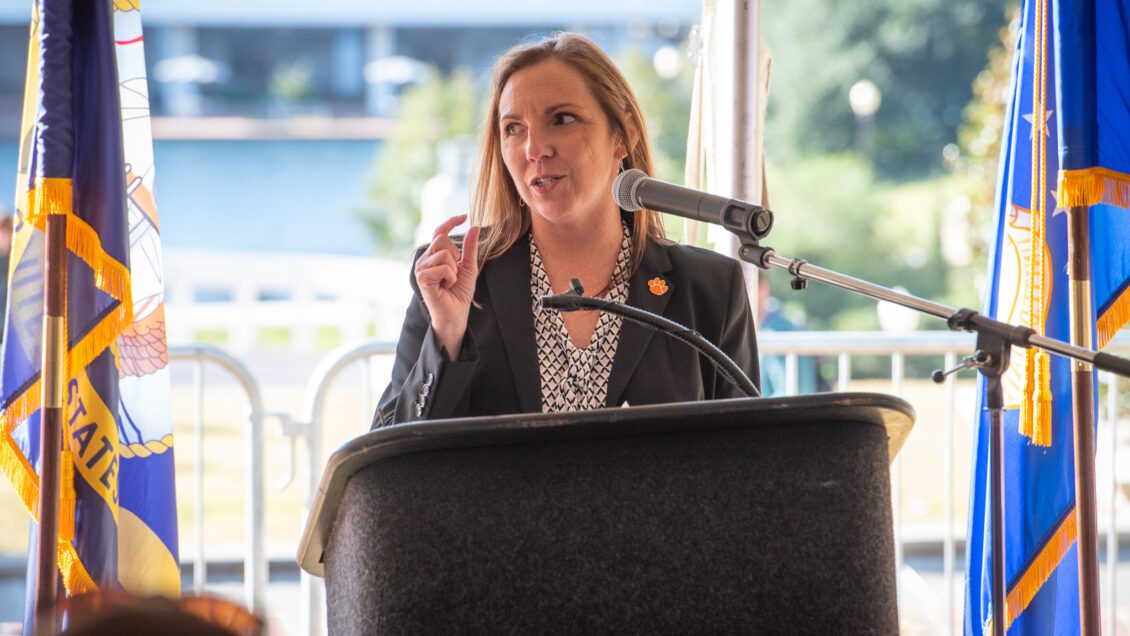Whether it’s responding to a report of smoke in a building on campus, preparing for a hurricane approaching South Carolina or helping coordinate the logistics of a home football game, Director of Emergency Management Sarah Custer and her team go to work to do whatever is needed.
We sat down with Custer to learn more about her role and all the ways that Emergency Management helps the University to prepare and respond to emergencies.
What is your role as Director of Emergency Management?
My role is to build and maintain a comprehensive emergency management team and program that integrates improving both individual and enterprise preparedness and resiliency. To accomplish this, I am responsible for overseeing enterprise-wide incident and emergency preparedness to include strategic planning, fiscal oversight, and development and revision of EM programs, policies and initiatives.
I have the honor of leading a team of outstanding Emergency Managers who manage key programs, and I coordinate the Emergency Management Council and Emergency Operations Center to enhance our prevention, protection, mitigation, response and recovery capabilities regarding the threats and hazards that pose the greatest threats to all Clemson University locations.
How would you describe Emergency Management’s role at Clemson University?
The Office of Emergency Management really dedicates our time and energy to three key areas: Foster a secure and resilient environment that safeguards the well-being of our diverse community; Sustain our educational, research and service missions in the face of emergencies and disasters; Cultivate a culture of preparedness and proactive response to crises.
EM is committed to proactive planning, collaborative partnerships, innovation, effective response and continuous improvement. Fostering a secure and resilient Clemson University through all hazards prevention, protection, mitigation, response and recovery is a crucial part of our mission.
Our Emergency Managers work to create a culture of preparedness by helping individuals and CU organizations to Be Informed, Make a Plan and Build a Kit. We manage the CU Safe Alert program to provide emergency notifications, the Building Security Coordinators, who serve a critical role in providing for the preparedness and safety of their buildings, and the Emergency Management and Reception and Assistance Center Plans so we touch a lot of different areas.
We coordinate planning, training and exercises to strengthen the preparedness of the University, as well as our Emergency Management team and our first responders. We do the same with our Emergency Operations Center and work with the Executive Leadership Team Members to provide a well-coordinated response and recovery to minimize the impact of emergencies and to deliver outstanding support services.
What are some of the ways students benefit from the work of Emergency Management?
Students benefit from the Emergency Management team’s work through receiving timely and accurate emergency notifications, living and learning at an institution that works hard at all levels to prevent emergencies and is prepared to effectively respond to, recover from, and adapt through them, returning to normal quickly.
From Building Security Coordinators, who quickly identify and correct facility issues and provide clear evacuation and sheltering instructions, to response, to organizations providing care after disasters, emergency management works to coordinate the efforts to provide these critical services and more to our students.
September is National Preparedness Month. Why is being prepared for emergencies so important?
Natural Disasters, man-made emergencies and technological failures can happen anywhere and at any time. While Clemson University has exceptional plans and responders, getting help takes time. Prepared individuals are more independent, able to reduce losses and anxiety, are more self-reliant, serve as reassurance for others and can recover more quickly and with fewer long-term effects.
When you take the time to Be Informed, Make a Plan, and Build a Kit, you will be more prepared to survive, allow responders to focus on critical needs and to help take care of your friends, family, classmates and co-workers as you are the help until help arrives.
It’s also hurricane season and some Clemson sites were recently impacted by Hurricane Idalia. How does Emergency Management help Clemson locations across the state prepare for and respond to hurricanes?
Emergency Management helps the strong teams at sites across the state prepare for hurricanes by assisting with plan development and maintenance, tools to assist individuals with their hurricane plans and providing emergency notification capabilities. We help them respond to and recover from hurricanes by providing regular updates on the forecast and projected impacts, state and county operations to include evacuation and coordination of support if it is needed.
Everyone living in SC is susceptible to hurricane impacts at some level and should be prepared. From teams in SC Hurricane Evacuation Zones which include Coastal REC, the Clemson University Restoration Institute, the Clemson Design Center in Charleston, the CU Bioengineering Program at MUSC, and the Baruch Institute of Coastal Ecology and Forest Science; to those outside of the evacuation zones, but still close enough to experience significant impacts such as Edisto and Pee Dee RECs; to the rest of the sites in SC that may experience flooding, high winds and possibly tornadoes that include sites near Columbia and all across the update, and our Cooperative Extension agents located in all 46 counties of SC, Emergency Management is committed to providing outstanding and personalized service that each location needs.
Learn more about Emergency Management.

